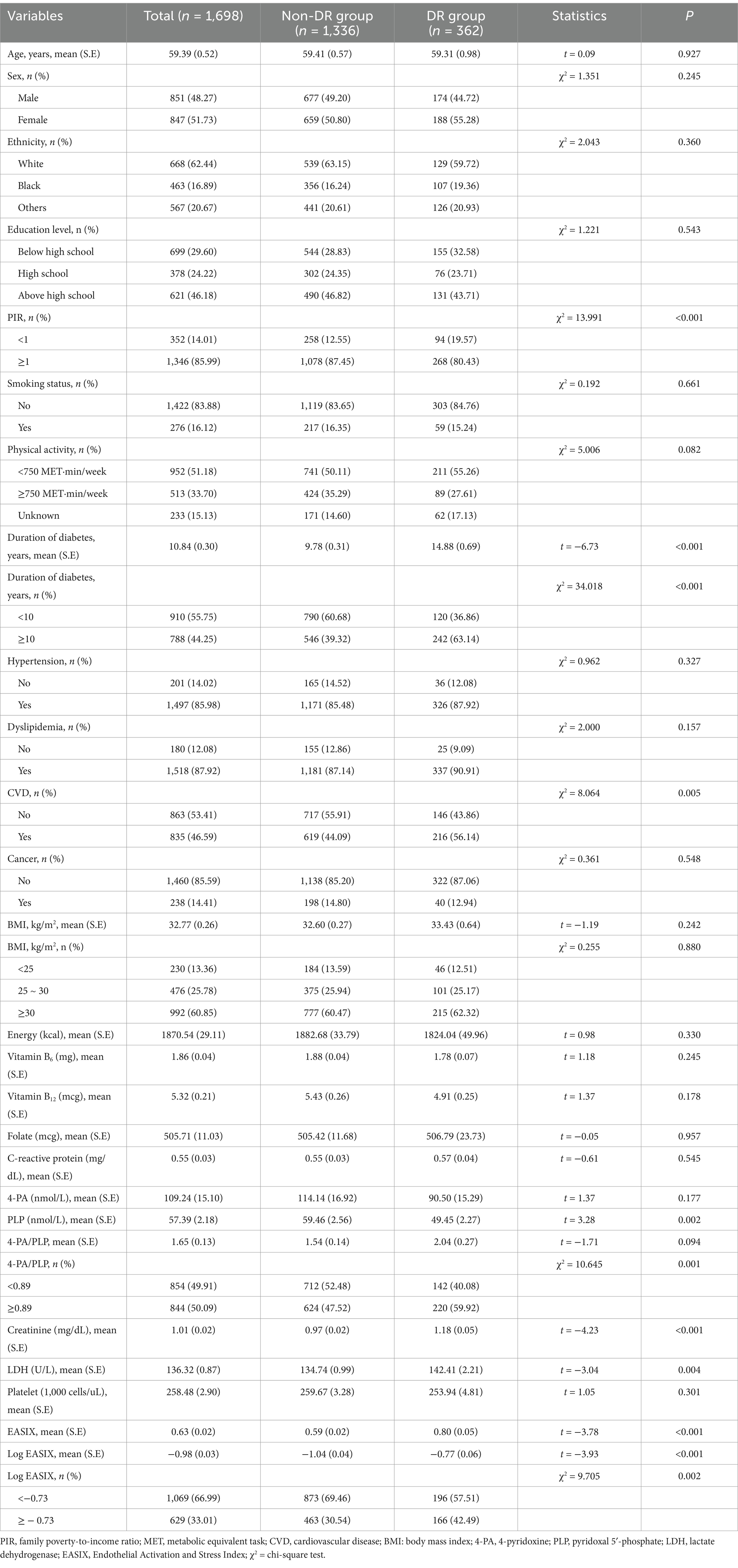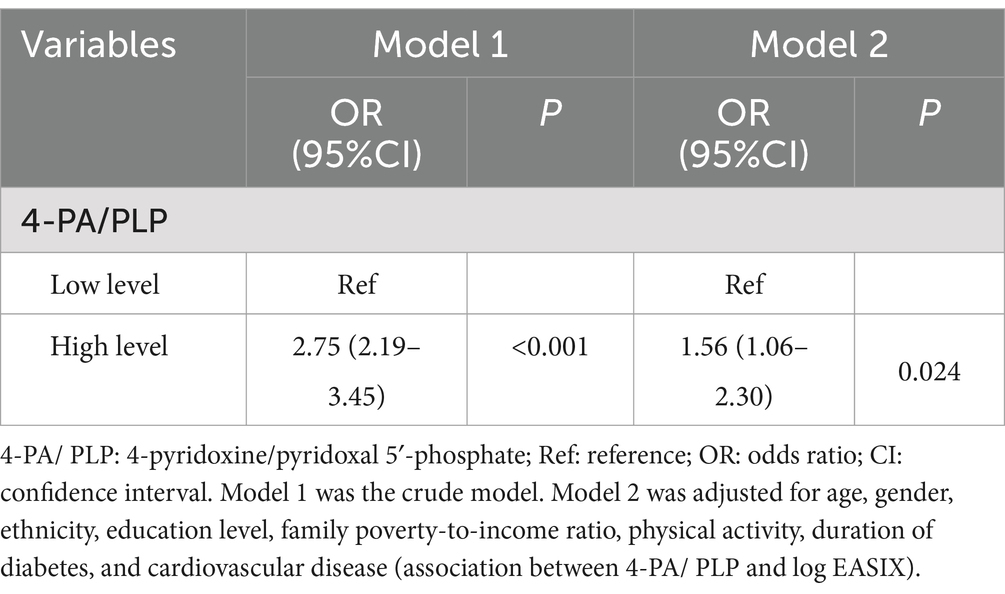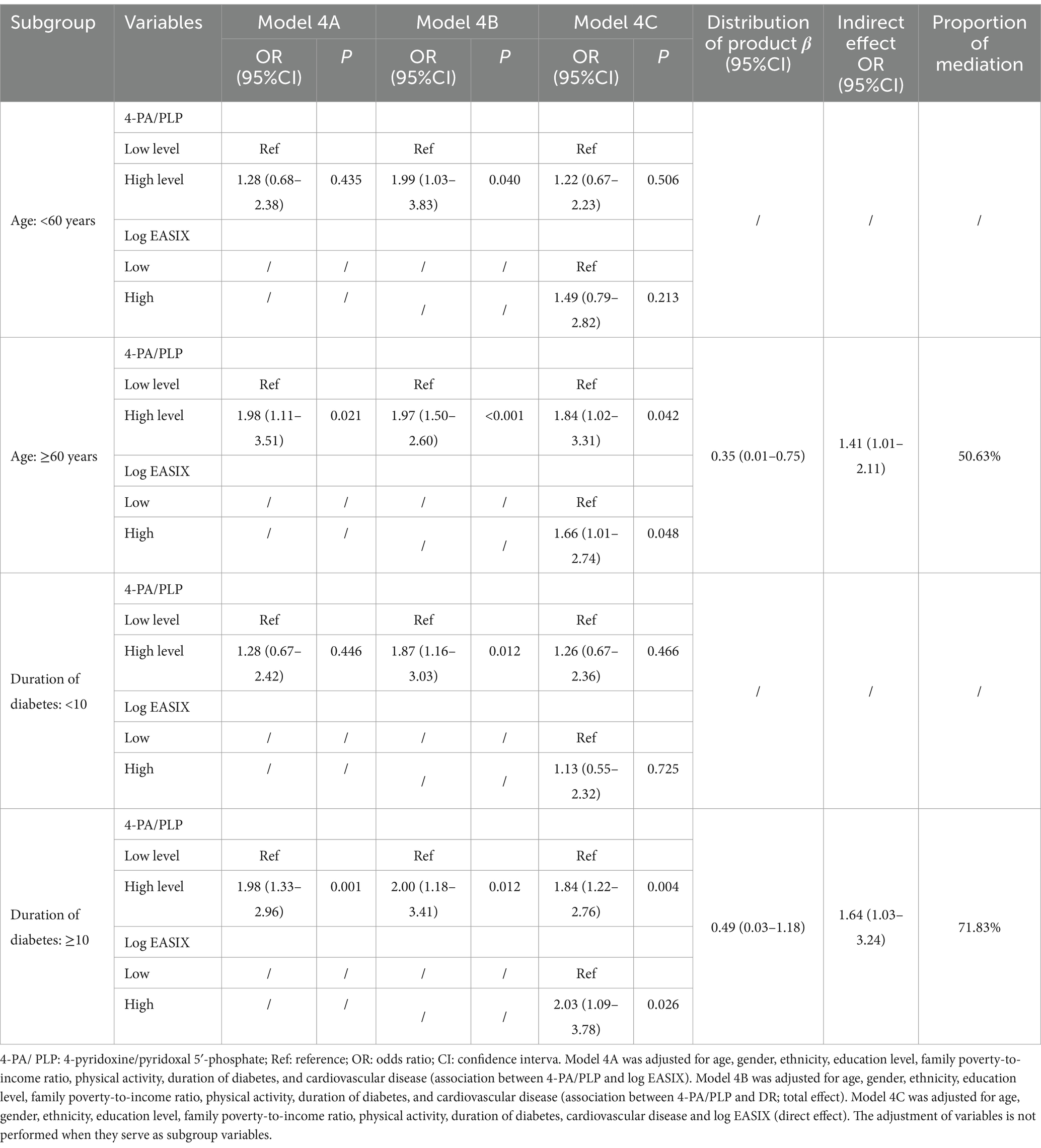- Department of Ophthalmology, The Affiliated Hospital of Hangzhou Normal University, Hangzhou, China
Aim: This study aimed to explore the association between the ratio of 4-pyridoxine (4-PA) to pyridoxal 5′-phosphate (PLP) (4-PA/PLP) and diabetic retinopathy (DR) and further assess the mediating effect of Endothelial Activation and Stress Index (EASIX) on the association between 4-PA/PLP and DR.
Methods: In this cross-sectional study, 1,698 patients with diabetes from the National Health and Nutrition Examination Survey were included. According to the median, 4-PA/PLP was categorized into a high-level group (≥0.89) and a low-level group (<0.89). As the EASIX had a skewed distribution, it was log-transformed before analysis. Weighted logistic regression models were used to investigate the association of 4-PA/PLP with EASIX and DR and the mediating effect of EASIX on the association between 4-PA/PLP and DR. The distribution-of-product method was adopted to assess the mediating effect. Subgroup analysis was performed based on the age and duration of diabetes.
Results: A total of 362 diabetic patients were classified as having DR. After adjusting for all covariates, a higher level of 4-PA/PLP was associated with an increased level of log EASIX [odds ratio (OR) = 1.56, 95% confidence interval (CI): 1.06–2.30]. A higher ratio of 4-PA/PLP was associated with increased odds of DR compared to the reference group with lower levels of 4-PA/PLP (OR = 1.94, 95%CI: 1.40–2.67). In addition, we found that log EASIX may play a mediating role in the 4-PA/PLP and DR, with a 95% CI of distribution of product of 0.31 (95% CI: 0.02–0.67). The proportion of mediation was 69.06%. The mediating effect of log EASIX was also observed in individuals with diabetes who were aged≥60 years (proportion of mediation: 50.63%) or had a duration of diabetes ≥10 years (proportion of mediation: 71.83%).
Conclusion: This study found a positive association between high levels of 4-PA/PLP and an increased risk of DR, with the relationship being partially mediated by log EASIX.
Introduction
Diabetic retinopathy (DR) is one of the most common and specific microvascular complications of diabetes (1). According to the report of a systematic review and meta-analysis, the global population with DR was estimated to be 103.12 million in 2020 and is projected to increase to 160.50 million in 2045 (2). DR not only significantly contributes to the development of blindness and visual impairment but also is associated with an increased risk of all-cause mortality (3). DR has imposed a significant disease burden worldwide (2).
Endothelial dysfunction is an important pathological mechanism for the occurrence and development of DR (4, 5). However, the accuracy and reproducibility of assessing endothelial function, specifically flow-mediated dilation, are susceptible to operator variability, and there is no universally recognized biomarker for evaluating endothelial function. Recently, a novel Endothelial Activation and Stress Index (EASIX) based on biochemical markers including lactate dehydrogenase (LDH), creatinine, and platelets has been proposed and utilized for investigating the prognostic implications in patients with severe diseases and cancer (6, 7). However, there is currently a lack of research exploring the association between the EASIX and DR.
Vitamin B6 is a crucial micronutrient for the human body, and its anti-inflammatory properties have been progressively elucidated (8). Recent studies have indicated that reduced vitamin B6 intake may be linked to an elevated risk of developing DR and an increased mortality rate in patients with DR (9, 10), potentially due to the suppression of superoxide production in microvascular endothelial cells and the inflammatory response (10, 11). It is well known that dietary intake may not accurately reflect the body’s vitamin B6 levels and does not reflect the catabolic status of vitamin B6 catabolism status. Several studies have found that vitamin B6 catabolism, or vitamin B6 turnover, was strongly correlated with the risk of mortality (12, 13) and cardiovascular disease (CVD) (14) in individuals with diabetes. This association is reflected by the ratio of 4-pyridoxine (4-PA) to pyridoxal 5′-phosphate (PLP) (4-PA/PLP), a blood marker that is linked to vitamin B6 levels. This ratio integrates changes in vitamin B6 metabolism mediated by inflammation and serves as a functional indicator of inflammatory status and dysregulation in vitamin B6 metabolism (14). Chronic inflammation plays a crucial role in the pathogenesis of DR associated with endothelial dysfunction (4, 5). However, few studies have investigated the correlation between the 4-PA/PLP ratio and DR, as well as whether this ratio influences DR risk through its impact on endothelial function.
In light of this background, our study aimed to explore the association between 4-PA/PLP and DR and further assess the mediating effect of EASIX on this association. It is hoped that this study could contribute to the early identification of high-risk populations and provide some references for DR management.
Methods
Data sources
In this cross-sectional study, all data were obtained from the National Health and Nutrition Examination Survey (NHANES) database. The NHANES is a complex, multistage, and probabilistic sampling design survey, which combines interview information with physical examination data (15). All NHANES participants provided written consent to participate in the survey, and their data collection received approval from the National Center for Health Statistics Research Ethics Review Board.
Study eligibility criteria
Initially, our study included 2,983 patients with diabetes who were aged ≥20 years from the NHANES 2005–2010. Of those, 1,285 patients with diabetes were excluded from this study due to the following reasons: (1) patients with missing data on 4-PA (n = 283) or PLP (n = 3); (2) patients with missing data on LDH (n = 9), creatinine (n = 39), and platelets (n = 6); and (3) patients with missing information of retinal lesions (n = 945). Finally, 1,698 patients with diabetes were included in our final analyses and categorized into two groups based on DR status [DR group (n = 362) and non-DR group (n = 1,336)] (Figure 1).
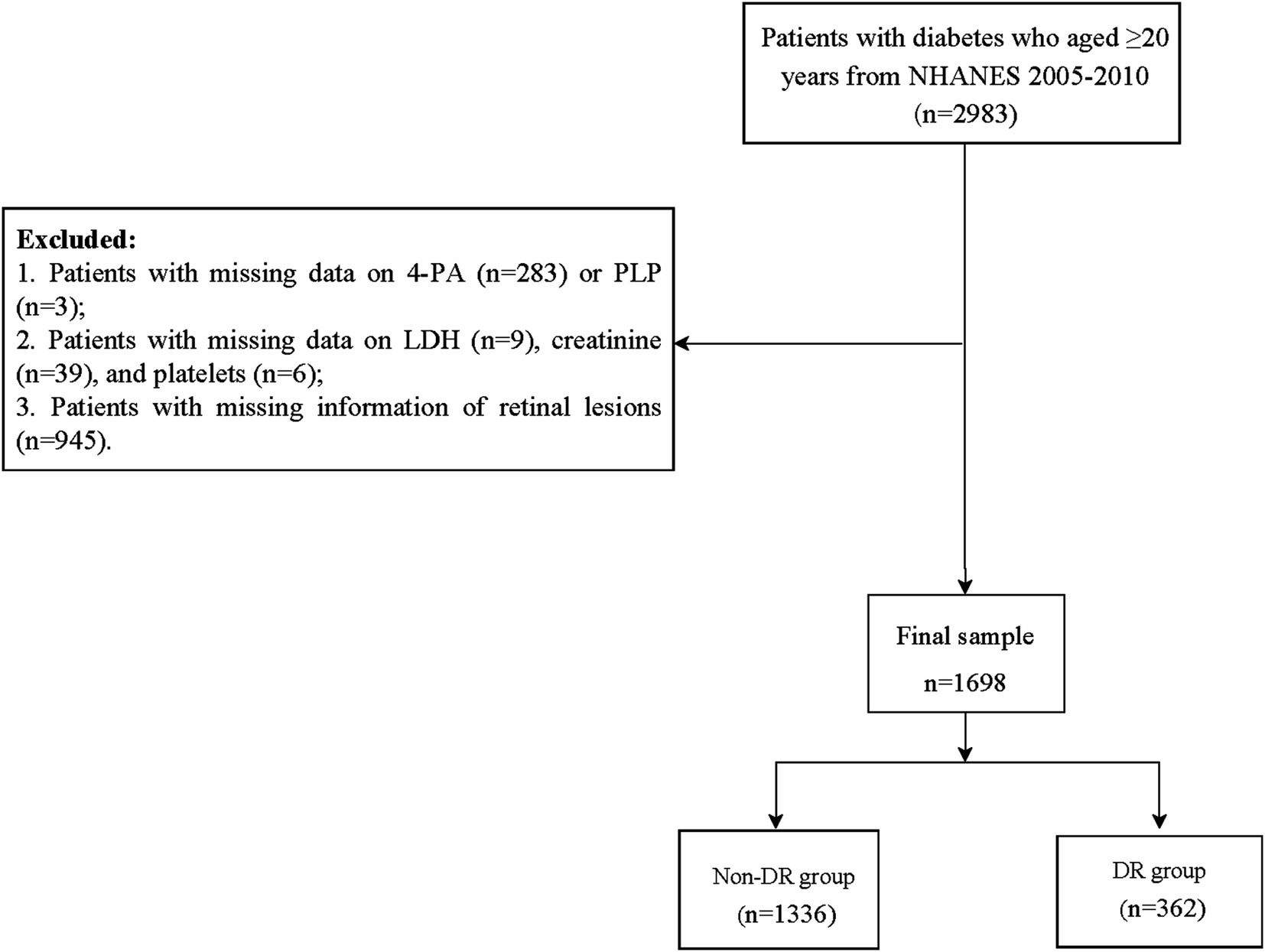
Figure 1. Flowchart of the participants screening. NHANES, National Health and Nutrition Examination Survey; 4-PA, 4-pyridoxine; PLP, pyridoxal 5′-phosphate; LDH, lactate dehydrogenase; DR, diabetic retinopathy.
Data collection
Assessment of diabetes and DR
Diabetes was defined based on self-reported diagnosis, use of hypoglycemic medication, or the following criteria: glycohemoglobin A1c (HbA1c) ≥6.5%, fasting glucose ≥126 mg/dL, and 2-h plasma glucose ≥200 mg/dL during the oral glucose tolerance test (OGTT) (16). The assessment for DR was based on individuals who responded “Yes” to the question “Has a doctor ever told you that diabetes has affected your eyes or that you have retinopathy?”.
Measurement of 4-PA/PLP and EASIX
For NHANES participants, the serum 4-PA and PLP concentrations were determined using high-performance liquid chromatography. More methodological details can be found in the laboratory procedure manual provided by the NHANES: https://wwwn.cdc.gov/Nchs/Nhanes/2009-2010/VIT_B6_F.htm. 4-PA/PLP was calculated as 4-PA÷PLP concentration. Based on the median, 4-PA/PLP was categorized into a high-level group (≥0.89) and a low-level group (<0.89).
The EASIX score was calculated using the formula: LDH (U/L) × creatinine (mg/dL) /platelet count (109/L). As the EASIX had a skewed distribution, it was log-transformed before analysis. Log EASIX was divided into two groups: high (≥ − 0.73) and low (<−0.73).
Covariates
Patient information collected included age, gender, ethnicity, education level, family poverty-to-income ratio (PIR), smoking status, physical activity, duration of diabetes, hypertension, dyslipidemia, CVD, cancer, body mass index (BMI, kg/m2), energy (kcal), vitamin B6 (mg), vitamin B12 (mcg), folate (mcg), and C-reactive protein (CRP, mg/dL). A history of hypertension was defined as a self-reported physician diagnosis, systolic blood pressure (SBP) ≥130 mmHg, diastolic blood pressure (DBP) ≥80 mmHg, or use of antihypertensive medication. The duration of diabetes was calculated by subtracting the age at onset from the current age. In the NHANES database for 2005–2006, no information regarding the supplement usage of vitamin B6, vitamin B12, and folate was available. In the NHANES 2007–2010, the prevalence of missing data for vitamin B6 supplements was approximately 75.46%, while for vitamin B12 supplements, it was approximately 74.27%, and for folate supplements, it was approximately 75.69%. Given that there are too many missing or no data on vitamin B6, vitamin B12, and folate supplements in the NHANES database, the data collected for this study solely relied on dietary intake. The data on vitamin B6, vitamin B12, and folate were estimated by calculating the daily diet intake obtained from the NHANES Dietary Data section.
Statistical analysis
Considering the complex survey design in the NHANES, all analyses applied the appropriate sampling weights for NHANES data. Weighted variables such as SDMVPSU, SDMVSTRA, and WTMEC2YR were used in this study. Categorical variables were expressed as the number of cases and composition ratio [n (%)] and were statistically analyzed between groups using the chi-square test. Continuous variables were expressed as mean ± standard error (SE) and were analyzed between groups using a weighted t-test. Missing variables were interpolated using the multiple imputation method, and sensitivity analysis is shown in Supplementary Table S1.
Weighted logistic regression models were used to investigate the association of 4-PA/PLP with EASIX and DR and the mediating effect of EASIX on the association between 4-PA/PLP and DR. The distribution-of-product method was adopted to assess the mediating effect, with the 95% confidence interval (CI) for the product distribution calculated using the “RMediation” software package. A mediation effect is considered significant when the CI does not include 0. The proportion of mediation was calculated based on both indirect and total effects. In addition, subgroup analysis was performed to test whether the mediating effect of EASIX could be altered by age and duration of diabetes. The odds ratio (OR) with a corresponding 95% CI was calculated. p < 0.05 was considered statistically significant.
Results
General characteristics of study participants
A total of 1,698 patients with diabetes were included in our study. Table 1 shows the general characteristics of all included participants, with 48.27% of the participants being male. The average age of patients with diabetes was 59.39 (0.52) years. The mean BMI was 32.77 (0.26) kg/m2. Among the 1,698 patients, 362 patients with diabetes were classified as having DR. In general, participants with DR were more likely to have a lower proportion of PIR, longer duration of diabetes, higher proportion of CVD, and higher levels of creatinine, LDH, and EASIX than those without DR.
Association between 4-PA/PLP and log EASIX
We used the weighted univariate logistic regression analysis to screen the covariates, and the result is shown in Supplementary Table S2. Table 2 presents the association between 4-PA/PLP and log EASIX using the weighted logistic regression models. In the unadjusted model, a high level of 4-PA/PLP was associated with an increased level of log EASIX (Model 1: OR = 2.75, 95%CI: 2.19–3.45, p < 0.001). After adjusting for age, gender, ethnicity, education level, PIR, physical activity, duration of diabetes, and CVD, the association between 4-PA/PLP and log EASIX remained (Model 2: OR = 1.56, 95%CI: 1.06–2.30, p = 0.024).
The mediating effect of log EASIX among the total population and its subgroups
After adjusting for all covariates, a high level of 4-PA/PLP was associated with an increased odd of DR compared to the reference group with low levels of 4-PA/PLP (Model 3A: OR = 1.94, 95%CI: 1.40–2.67, p < 0.001). The mediating effect of log EASIX on the association between 4-PA/PLP and DR is presented in Table 3. We found that log EASIX may play a mediating role in the 4-PA/PLP and DR, with a 95% CI of distribution of product of 0.31 (95% CI: 0.02–0.67). The proportion of mediation was 69.06%. Figure 2 shows the path diagram of the mediation analysis models. In addition, the mediating effect of log EASIX was also observed in individuals with diabetes who were aged ≥60 years (proportion of mediation: 50.63%) or had a duration of diabetes ≥10 years (proportion of mediation: 71.83%) (Table 4 and Supplementary Figure S1).
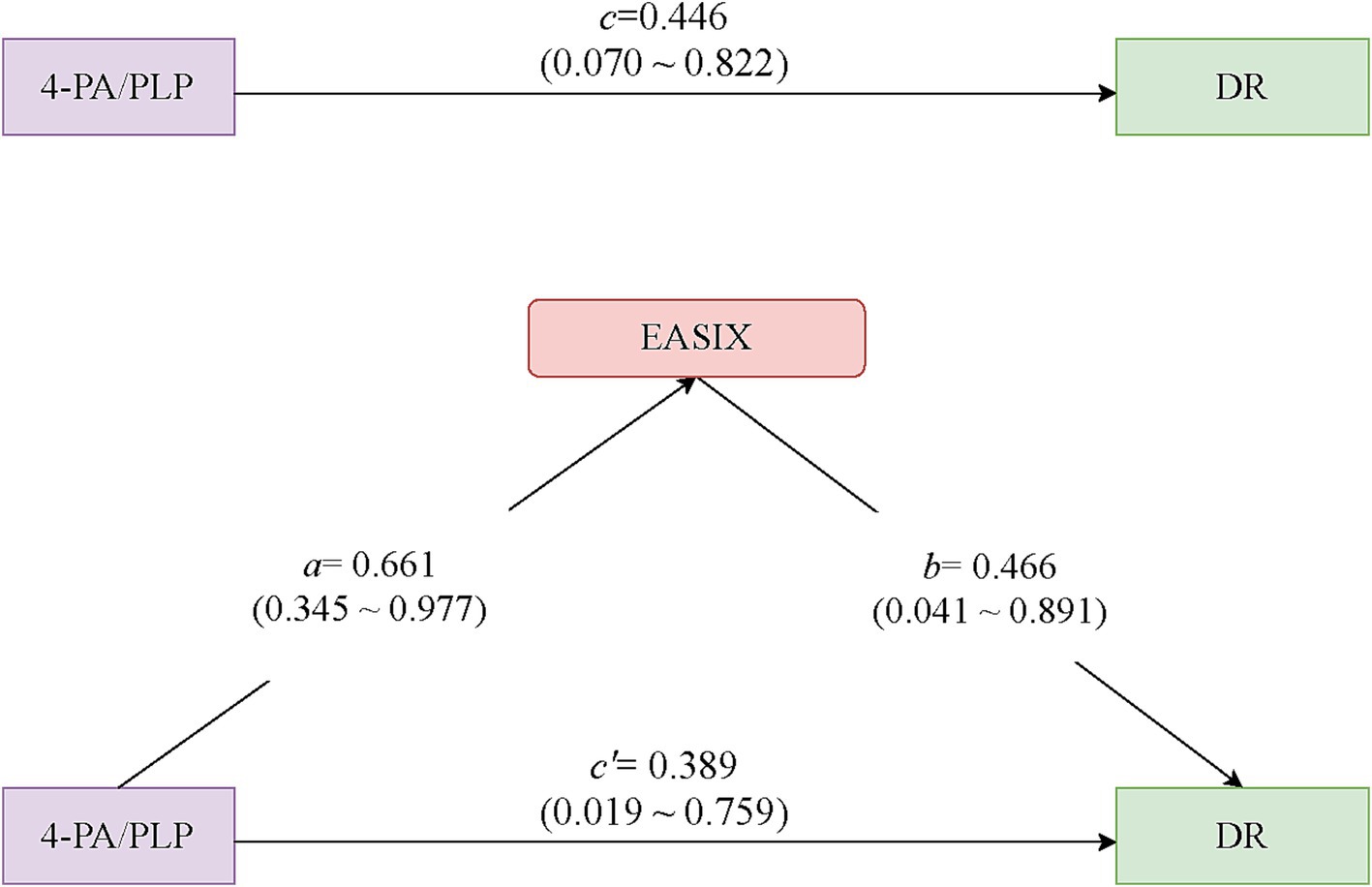
Figure 2. Path diagram of the mediation analysis models. Path a: estimated coefficient for the regression with 4-PA/PLP predicting log EASIX; Path b: estimated coefficient for the regression with log EASIX predicting DR; Path c = total effects for the regression with 4-PA/PLP predicting DR; Path c’ = direct effects for the regression with 4-PA/PLP predicting DR independent of log EASIX. 4-PA/PLP: the ratio of 4-pyridoxine (4-PA) to pyridoxal 5′-phosphate (PLP); EASIX: Endothelial Activation and Stress Index; DR: diabetic retinopathy.
Discussion
In the present study, we explored the associations between 4-PA/PLP, EASIX, and DR among patients with diabetes using the NHANES data. The findings suggested positive associations between high levels of 4-PA/PLP and log EASIX, as well as between high levels of 4-PA/PLP and DR. Interestingly, we found that log EASIX mediates the association between 4-PA/PLP and DR, with a mediation proportion of 69.06%. A significant mediating effect of log EASIX was more likely to occur among individuals with diabetes who were aged ≥60 years or had a duration of diabetes ≥10 years.
Vitamin B6 is a crucial nutrient. There was evidence linking the relationship between vitamin B6 and DR risk. An analysis of the data from the Japan Diabetes Complications Study revealed a significant inverse association between high vitamin B6 intake and the incidence of DR in individuals with type 2 diabetes in Japan, suggesting a potential protective role of increased vitamin B6 consumption (10). In a narrative review, a high dietary intake of vitamin B6 was also found to significantly reduce the risk of DR following an 8-year follow-up period (17). The involvement of inflammation in the pathogenesis of DR is widely acknowledged (18). Vitamin B6 has been recognized for its antioxidant and anti-inflammatory properties, as well as its ability to modulate immunity and gene expression (19). An anti-inflammatory diet intake may decrease the levels of inflammatory markers and consequently lower the likelihood of developing DR. In addition, the deficiency of vitamin B6 leads to an increase in homocysteine levels (20). Elevated homocysteine is considered a risk factor for DR (21). Similar to previous research, our study found that a high level of 4-PA/PLP was related to increased DR risk. PLP serves as a coenzyme form of vitamin B6, playing a pivotal role in catalyzing over 160 diverse functions (22). 4-PA represents the primary metabolite of vitamin B6 (23). 4-PA/PLP was used as an indicator for assessing vitamin B6 turnover, reflecting a state of low vitamin B6 status due to altered tissue distribution or increased vitamin B6 turnover (24).
Endothelial cells play crucial roles in maintaining retinal vascular homeostasis (25). Retinal vascular dysfunction is induced by various factors, including advanced glycosylation end products and receptors, oxidative stress, pro-inflammatory cytokines and chemokines, proliferator-activated receptor-γ disruption, growth factors, and microRNA; these factors contribute to the impairment of retinal endothelial function, ultimately leading to the development of DR (4). The focus on markers of endothelial dysfunction as biomarkers of DR may be reasonable. EASIX, as a marker of endothelial injury, has been validated as an easily predictive biomarker for the prediction of survival outcomes in various medical conditions (26–28). However, there is a lack of research investigating the correlation between EASIX and the progression of DR. In this study, we observed that a high level of log EASIX was associated with an increased risk of DR. In addition, a positive association between 4-PA/PLP and log EASIX was found in this study. Oxidative stress is characterized by the imbalance between oxidation product levels and the body’s antioxidant capacity (29). Several studies revealed that nutrition rich in antioxidant properties possesses the ability to effectively scavenge free radicals and reactive oxygen species (ROS), thereby mitigating oxidative stress among individuals with diabetes (30, 31). A higher level of vitamin B6 was found to normalize endothelial dysfunction in children with type 1 diabetes (32). This might explain the relationship between 4-PA/PLP and log EASIX.
To the best of our knowledge, this is the first study to explore the mediating effect of log EASIX for the association between 4-PA/PLP and DR among individuals with diabetes based on the NHANES data. The results showed that log EASIX partially mediated the relationship between 4-PA/PLP and DR risk, offering valuable insights into the potential role of endothelial function indicators in this relationship. In addition, the mediation proportion of log EASIX was 69.06%, indicating that it was largely involved in the process of 4-PA/PLP on the development of DR. In other words, the association between 4-PA/PLP and DR risk was serially mediated through the 4-PA/PLP-endothelial dysfunction path and the endothelial dysfunction-DR path, suggesting that 4-PA/PLP accelerated endothelium dysfunction and finally aggravated the DR progress.
The finding emphasizes the importance of reducing DR risk by improving endothelial dysfunction, especially in populations with high 4-PA/PLP. Simultaneously, we observed the specificity of age and diabetes duration in the mediating role of log EASIX between 4-PA/PLP and DR risk using stratified analysis. Log EASIX was not mediated in the individuals with diabetes who were aged <60 years, and it might be suggested that for the individuals with diabetes who were aged ≥60 years, reducing the EASIX would be the focus for preventing DR occurrence. Furthermore, among individuals with diabetes and a duration of diabetes ≥10 years, log EASIX partially mediated the association between 4-PA/PLP and DR risk (mediation proportion: 71.83%). However, among those with a duration of diabetes <10 years, the effect of 4-PA/PLP on the development of DR did not appear to be mediated by log EASIX. This finding may provide new insights into the reduced risk of DR in diabetes duration-specific populations.
Nevertheless, some limitations of our study should not be ignored. First, our study was cross-sectional; we cannot establish a causal relationship between 4-PA/PLP, EASIX, and DR. Second, we adjusted for many potential confounders, but we cannot entirely exclude the possibility of unmeasured confounders, such as medication therapy. Third, data on DR were collected by self-report, which might potentially introduce recall bias. In addition, due to the substantial amount of missing or unavailable data on vitamin B6, vitamin B12, and folate supplements in the NHANES database, the data collected for this study solely relied on dietary intake. Finally, similar to the majority of NHANES studies, the results of this study are limited to the US population, and the results need to be interpreted with caution. Further research is essential to confirm our findings in a prospective study.
Conclusion
This study identified a positive association between high levels of 4-PA/PLP and an increased risk of DR, with the relationship partially mediated by log EASIX. Further prospective studies are necessary to examine the effects of EASIX on the relationship between 4-PA/PLP and DR.
Data availability statement
Publicly available datasets were analyzed in this study. This data can be found here: NHANES database, https://wwwn.cdc.gov/nchs/nhanes/.
Ethics statement
The requirement of ethical approval was waived by the Affiliated Hospital of Hangzhou Normal University for the studies involving humans because the Affiliated Hospital of Hangzhou Normal University. The studies were conducted in accordance with the local legislation and institutional requirements. The participants provided their written informed consent to participate in this study.
Author contributions
JY: Conceptualization, Project administration, Supervision, Writing – original draft, Writing – review & editing. JC: Data curation, Formal analysis, Investigation, Methodology, Writing – review & editing. YC: Data curation, Formal analysis, Investigation, Methodology, Writing – review & editing.
Funding
The author(s) declare that no financial support was received for the research, authorship, and/or publication of this article.
Conflict of interest
The authors declare that the research was conducted in the absence of any commercial or financial relationships that could be construed as a potential conflict of interest.
Publisher’s note
All claims expressed in this article are solely those of the authors and do not necessarily represent those of their affiliated organizations, or those of the publisher, the editors and the reviewers. Any product that may be evaluated in this article, or claim that may be made by its manufacturer, is not guaranteed or endorsed by the publisher.
Supplementary material
The Supplementary material for this article can be found online at: https://www.frontiersin.org/articles/10.3389/fnut.2024.1490340/full#supplementary-material
SUPPLEMENTARY FIGURE S1 | The mediating effect of log EASIX on the association between 4-PA/PLP and DR risk in the age and diabetes duration subgroups. 4-PA/PLP: the ratio of 4-pyridoxine (4-PA) to pyridoxal 5’-phosphate (PLP); EASIX: Endothelial Activation and Stress Index; DR: diabetic retinopathy.
References
1. Cheung, N, Mitchell, P, and Wong, TY. Diabetic retinopathy. Lancet. (2010) 376:124–36. doi: 10.1016/s0140-6736(09)62124-3
2. Teo, ZL, Tham, YC, Yu, M, Chee, ML, Rim, TH, Cheung, N, et al. Global prevalence of diabetic retinopathy and projection of burden through 2045: systematic review and Meta-analysis. Ophthalmology. (2021) 128:1580–91. doi: 10.1016/j.ophtha.2021.04.027
3. Modjtahedi, BS, Wu, J, Luong, TQ, Gandhi, NK, Fong, DS, and Chen, W. Severity of diabetic retinopathy and the risk of future cerebrovascular disease, cardiovascular disease, and all-cause mortality. Ophthalmology. (2021) 128:1169–79. doi: 10.1016/j.ophtha.2020.12.019
4. Gui, F, You, Z, Fu, S, Wu, H, and Zhang, Y. Endothelial dysfunction in diabetic retinopathy. Front Endocrinol. (2020) 11:591. doi: 10.3389/fendo.2020.00591
5. Yang, J, and Liu, Z. Mechanistic pathogenesis of endothelial dysfunction in diabetic nephropathy and retinopathy. Front Endocrinol. (2022) 13:816400. doi: 10.3389/fendo.2022.816400
6. Sanchez-Escamilla, M, Flynn, J, Devlin, S, Maloy, M, Fatmi, SA, Tomas, AA, et al. Easix score predicts inferior survival after allogeneic hematopoietic cell transplantation. Bone Marrow Transplant. (2023) 58:498–505. doi: 10.1038/s41409-023-01922-8
7. Schult, D, Rasch, S, Schmid, RM, Lahmer, T, and Mayr, U. Easix is an accurate and easily available prognostic score in critically ill patients with advanced liver disease. J Clin Med. (2023) 12:553. doi: 10.3390/jcm12072553
8. Stach, K, Stach, W, and Augoff, K. Vitamin B6 in health and disease. Nutrients. (2021) 13:229. doi: 10.3390/nu13093229
9. Ruan, Y, Zhang, P, Jia, X, Hua, S, and Yao, D. Association of vitamin B6 intake with the risk and prognosis of diabetic retinopathy: a Nhanes-based study. Clin Exp Optom. (2024) 107:847–56. doi: 10.1080/08164622.2023.2300298
10. Horikawa, C, Aida, R, Kamada, C, Fujihara, K, Tanaka, S, Tanaka, S, et al. Vitamin B6 intake and incidence of diabetic retinopathy in Japanese patients with type 2 diabetes: analysis of data from the Japan diabetes complications study (Jdcs). Eur J Nutr. (2020) 59:1585–94. doi: 10.1007/s00394-019-02014-4
11. Yamagishi, S, Matsui, T, Nakamura, K, Yoshida, T, Takeuchi, M, Inoue, H, et al. Pigment-epithelium-derived factor suppresses expression of receptor for advanced glycation end products in the eye of diabetic rats. Ophthalmic Res. (2007) 39:92–7. doi: 10.1159/000099244
12. Li, F, Liu, X, Zhao, L, Wang, H, Zhang, L, Xing, W, et al. Vitamin B6 turnover predicts long-term mortality risk in patients with type 2 diabetes. Curr Dev Nutr. (2024) 8:102073. doi: 10.1016/j.cdnut.2023.102073
13. Zhang, D, Li, Y, Lang, X, and Zhang, Y. Associations of serum vitamin B6 status and catabolism with all-cause mortality in patients with T2dm. J Clin Endocrinol Metab. (2022) 107:2822–32. doi: 10.1210/clinem/dgac429
14. Obeid, R, Geisel, J, and Nix, WA. 4-Pyridoxic Acid/Pyridoxine Ratio in Patients with Type 2 Diabetes Is Related to Global Cardiovascular Risk Scores. Diagnostics. (2019) 9:28. doi: 10.3390/diagnostics9010028
15. Song, L, Li, H, Fu, X, Cen, M, and Wu, J. Association of the Oxidative Balance Score and Cognitive Function and the mediating role of oxidative stress: evidence from the National Health and nutrition examination survey (Nhanes) 2011-2014. J Nutr. (2023) 153:1974–83. doi: 10.1016/j.tjnut.2023.05.014
16. McClure, ST, Schlechter, H, Oh, S, White, K, Wu, B, Pilla, SJ, et al. Dietary intake of adults with and without diabetes: results from Nhanes 2013-2016. BMJ Open Diabetes Res Care. (2020) 8:e001681. doi: 10.1136/bmjdrc-2020-001681
17. Ruamviboonsuk, V, and Grzybowski, A. The roles of vitamins in diabetic retinopathy: a narrative review. J Clin Med. (2022) 11:490. doi: 10.3390/jcm11216490
18. Atlı, H, Onalan, E, Yakar, B, Duzenci, D, and Dönder, E. Predictive value of inflammatory and hematological data in diabetic and non-diabetic retinopathy. Eur Rev Med Pharmacol Sci. (2022) 26:76–83. doi: 10.26355/eurrev_202201_27750
19. Bird, RP. The emerging role of vitamin B6 in inflammation and carcinogenesis. Adv Food Nutr Res. (2018) 83:151–94. doi: 10.1016/bs.afnr.2017.11.004
20. Obeid, R, McCaddon, A, and Herrmann, W. The role of Hyperhomocysteinemia and B-vitamin deficiency in neurological and psychiatric diseases. Clin Chem Lab Med. (2007) 45:1590–606. doi: 10.1515/cclm.2007.356
21. Hoogeveen, EK, Kostense, PJ, Eysink, PE, Polak, BC, Beks, PJ, Jakobs, C, et al. Hyperhomocysteinemia is associated with the presence of retinopathy in type 2 diabetes mellitus: the Hoorn study. Arch Intern Med. (2000) 160:2984–90. doi: 10.1001/archinte.160.19.2984
22. Ueland, PM, Ulvik, A, Rios-Avila, L, Midttun, Ø, and Gregory, JF. Direct and functional biomarkers of vitamin B6 status. Annu Rev Nutr. (2015) 35:33–70. Epub 2015/05/15. doi: 10.1146/annurev-nutr-071714-034330
23. Huang, YC, Chang, SJ, Chiu, YT, Chang, HH, and Cheng, CH. The status of plasma homocysteine and related B-vitamins in healthy young vegetarians and nonvegetarians. Eur J Nutr. (2003) 42:84–90. doi: 10.1007/s00394-003-0387-5
24. Ulvik, A, Midttun, Ø, Pedersen, ER, Eussen, SJ, Nygård, O, and Ueland, PM. Evidence for increased catabolism of vitamin B-6 during systemic inflammation. Am J Clin Nutr. (2014) 100:250–5. doi: 10.3945/ajcn.114.083196
25. Storti, F, Pulley, J, Kuner, P, Abt, M, and Luhmann, UFO. Circulating biomarkers of inflammation and endothelial activation in diabetic retinopathy. Transl Vis Sci Technol. (2021) 10:8. doi: 10.1167/tvst.10.12.8
26. Go, SI, Park, S, Kang, MH, Kim, HG, Kang, JH, Kim, JH, et al. Endothelial activation and stress index (Easix) as a predictive biomarker in small cell lung Cancer. Cancer Biomark. (2022) 35:217–25. doi: 10.3233/cbm-220032
27. Xu, HB, Ye, Y, Xue, F, Wu, J, Suo, Z, and Zhang, H. Association between endothelial activation and stress index and 28-day mortality in septic Icu patients: a retrospective cohort study. Int J Med Sci. (2023) 20:1165–73. doi: 10.7150/ijms.85870
28. Song, GY, Jung, SH, Kim, K, Kim, SJ, Yoon, SE, Lee, HS, et al. Endothelial activation and stress index (Easix) is a reliable predictor for overall survival in patients with multiple myeloma. BMC Cancer. (2020) 20:803. doi: 10.1186/s12885-020-07317-y
29. Zaha, I, Muresan, M, Tulcan, C, Huniadi, A, Naghi, P, Sandor, M, et al. The role of oxidative stress in infertility. J Pers Med. (2023) 13:1264. doi: 10.3390/jpm13081264
30. Ahn, HY, Kim, M, Seo, CR, Yoo, HJ, Lee, SH, and Lee, JH. The effects of Jerusalem artichoke and fermented soybean powder mixture supplementation on blood glucose and oxidative stress in subjects with prediabetes or newly diagnosed type 2 diabetes. Nutr Diabetes. (2018) 8:42. doi: 10.1038/s41387-018-0052-y
31. Rehman, K, and Akash, MS. Nutrition and diabetes mellitus: how are they interlinked? Crit Rev Eukaryot Gene Expr. (2016) 26:317–32. doi: 10.1615/CritRevEukaryotGeneExpr.2016016782
Keywords: mediating effect, DR, 4-PA/PLP, EASIX, distribution-of-product method
Citation: Yin J, Chen J and Chen Y (2025) Mediation of endothelial activation and stress index in the association between vitamin B6 turnover rate and diabetic retinopathy: an analysis of the National Health and Nutrition Examination Survey. Front. Nutr. 11:1490340. doi: 10.3389/fnut.2024.1490340
Edited by:
Joshua W. Miller, Rutgers, The State University of New Jersey, United StatesReviewed by:
Reza Nemati, Canterbury Health Laboratories, New ZealandCosmin Mihai Vesa, University of Oradea, Romania
Copyright © 2025 Yin, Chen and Chen. This is an open-access article distributed under the terms of the Creative Commons Attribution License (CC BY). The use, distribution or reproduction in other forums is permitted, provided the original author(s) and the copyright owner(s) are credited and that the original publication in this journal is cited, in accordance with accepted academic practice. No use, distribution or reproduction is permitted which does not comply with these terms.
*Correspondence: Jie Yin, eWluamllMzU1OUAxNjMuY29t
 Jie Yin
Jie Yin Juan Chen
Juan Chen